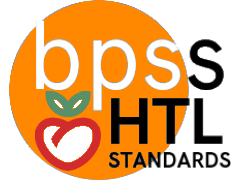BPS District Health Standards Book
Health Grade Levels
High School
High School Grade Band
HS Health "I can ... statements"
Standard 1: Growth and Development
HTL-HS.s1 Understand concepts related to human growth and development, health promotion, disease prevention.
- HTL-HS.s1.01: Predict and/or evaluate how health behaviors can affect health status.
- HTL-HS.s1.02: Analyze the interrelationships of mental, emotional, physical, and social health.
- HTL-HS.s1.03: Analyze how environment and personal health are interrelated.
- HTL-HS.s1.04: Analyze how genetics and family history can impact personal health.
- HTL-HS.s1.05: Formulate strategies to reduce or prevent injuries and health problems.
- HTL-HS.s1.06: Analyze the relationship between access to health care and health status.
- HTL-HS.s1.07: Analyze the benefits of and barriers to practicing a variety of health enhancing behaviors.
- HTL-HS.s1.08: Examine personal susceptibility to and severity of injury, illness, or death if engaging in unhealthy behaviors.
- HTL-HS.s1.09: Explain the functions of the reproductive system.
- HTL-HS.s1.10: Describe prenatal and postnatal practices that can contribute to or threaten a healthy pregnancy for parent and child.
- HTL-HS.s1.11: Compare and contrast the advantages and disadvantages of abstinence and other contraceptive methods, including condoms.
- HTL-HS.s1.12: Acknowledge differences among individuals regarding gender.
- HTL-HS.s1.13: Analyze characteristics of healthy and unhealthy relationships with family, peers, and other adults.
HTL-HS.s2 Analyze the influence of family, peers, culture, media, technology, and other factors on health behaviors.
- HTL-HS.s2.01: Analyze how the family influences the health of individuals.
- HTL-HS.s2.02: Analyze how culture, personal values, and beliefs support and challenge health behaviors.
- HTL-HS.s2.03: Analyze how peers influence health behaviors.
- HTL-HS.s2.04: Evaluate how the school and community can affect personal health behaviors.
- HTL-HS.s2.05: Evaluate the impact of media and technology on personal, family, and community health.
- HTL-HS.s2.06: Analyze how the perceptions of norms influence health behaviors.
- HTL-HS.s2.07: Examine how some health risk behaviors can influence the likelihood of engaging in other unhealthy behaviors.
- HTL-HS.s2.08: Analyze how public health policies and government regulations can influence health promotion and disease prevention.
Standard 3: Access Health Information
HTL-HS.s3 Demonstrate the ability to access valid health information, products and services.
- HTL-HS.s3.01: Evaluate the validity of health information, products, and services.
- HTL-HS.s3.02: Utilize valid health resources that protect and inform consumers.
- HTL-HS.s3.03: Evaluate the accessibility of products and services that enhance health.
- HTL-HS.s3.04: Determine when professional health services may be required.
Standard 4: Communication Skills
HTL-HS.s4 Demonstrate the ability to use interpersonal communication skills to enhance health and avoid or reduce health risks.
- HTL-HS.s4.01: Demonstrate active listening skills to enhance health and avoid or reduce health risks.
- HTL-HS.s4.02: Apply effective verbal and nonverbal refusal skills to enhance health and avoid or reduce health risks.
- HTL-HS.s4.03: Apply effective verbal and nonverbal negotiation skills to enhance health and avoid or reduce health risks.
- HTL-HS.s4.04: Apply effective verbal and nonverbal collaboration skills to enhance health and avoid or reduce health risks.
- HTL-HS.s4.05: Demonstrate strategies to prevent, manage, or resolve interpersonal conflicts without harming self or others.
- HTL-HS.s4.06: Demonstrate how to ask for and offer assistance to enhance the health of self and others.
HTL-HS.s5 Demonstrate the ability to use decision making skills to enhance health and avoid or reduce health risks.
- HTL-HS.s5.01: Examine barriers that can hinder healthy decision making.
- HTL-HS.s5.02: Apply the decision-making process in health-related situations.
- HTL-HS.s5.03: Justify when individual or collaborative decision making is appropriate.
- HTL-HS.s5.04: Generate alternatives to health-related issues or problems
- HTL-HS.s5.05: Predict the potential short-term and long-term impact of each alternative on self and others.
- HTL-HS.s5.06: Defend the healthy choice when making decisions.
- HTL-HS.s5.07: Evaluate the effectiveness of health-related decisions.
HTL-HS.s6 Demonstrate the ability to use goal setting skills to enhance health and avoid or reduce risks.
- HTL-HS.s6.01: Assess personal health status.
- HTL-HS.s6.02: Develop a plan to attain a personal health goal.
- HTL-HS.s6.03: Implement strategies to monitor progress in achieving a personal health goal.
- HTL-HS.s6.04: Formulate an effective short-term and long-term personal health plan.
HTL-HS.s7 Demonstrate the ability to practice health-enhancing behaviors and avoid or reduce health risks.
- HTL-HS.s7.01: Analyze the role of individual responsibility for enhancing health.
- HTL-HS.s7.02: Analyze a variety of health behaviors that will maintain or improve the health of self and others.
- HTL-HS.s7.03: Demonstrate health behaviors to avoid or reduce health risks to self and others.
HTL-HS.s8 Demonstrate the ability to advocate for personal, family, and community health.
- HTL-HS.s8.01: Utilize peer and societal norms to formulate a health-enhancing message.
- HTL-HS.s8.02: Demonstrate how to influence and support others to make positive health choices.
- HTL-HS.s8.03: Work cooperatively as an advocate for improving personal, family, and community health.
- HTL-HS.s8.04: Adapt health messages and communication techniques to a specific target audience.
